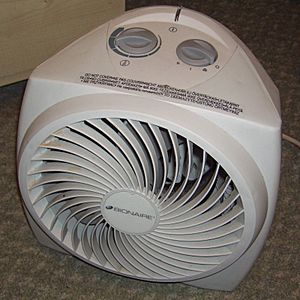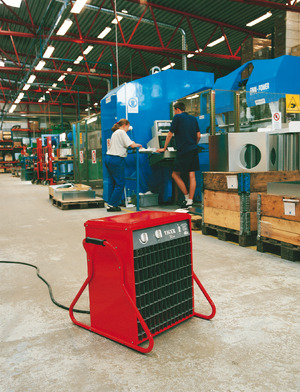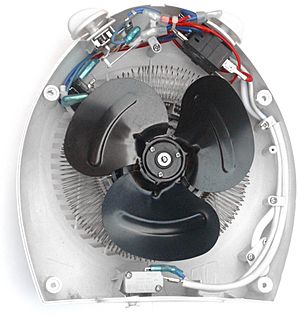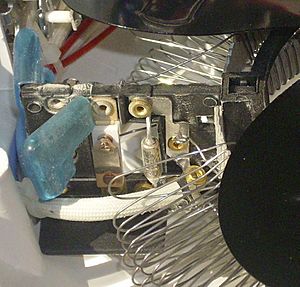Fan heater facts for kids
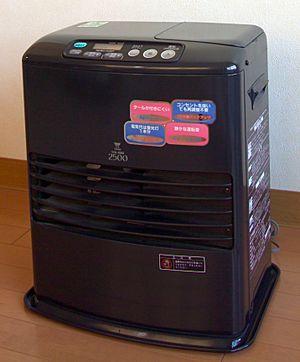
A fan heater is a type of heater that uses a fan to blow air over a hot part, like a heating element. This makes the air warm, and then the fan pushes the warm air out into the room. Fan heaters can warm up a room faster than heaters without a fan. However, because they have a fan, they do make some noise.
Contents
How Fan Heaters Work
Fan heaters are quite simple. They have a heating part inside that gets very hot. A fan then blows air over this hot part. As the air passes over the heat, it gets warm. The fan then pushes this warm air out into your room, making the whole space feel warmer.
Cost and Energy Use
Fan heaters are often cheaper to buy than other types of heaters. This is because they are built in a simple way. The fan helps to move heat away from the heater itself, which means the heater can be smaller without getting too hot.
When it comes to how much they cost to run, electric fan heaters can be more expensive than heaters that use fuel like gas or kerosene. This is because electricity can be more costly than other fuels. So, fan heaters are usually best for heating a room for a short time, rather than for heating your home all day long.
All electric heaters are very good at turning electricity into heat. This means almost all the energy they use ends up as useful heat in your room.
Controlling the Heat
Most modern fan heaters have different settings for how much heat they put out. Many also have a thermostat. A thermostat is like a smart switch that turns the heater on or off to keep the room at a certain temperature.
However, the thermostat is usually inside the heater itself. This means it senses the temperature right next to the heater, not necessarily the exact temperature across the whole room. Even so, for most uses, a basic fan heater with a thermostat works well enough to keep you comfortable.
Keeping Safe with Fan Heaters
It's important to use fan heaters safely. Since they have electrical parts inside, they should not be used in wet places. Water can cause an electrical injury if it touches the live parts.
Electric fan heaters usually have special safety features. They often have a safety switch that turns the heater off if it gets too hot. This can happen if the fan stops working or if the air vents get blocked. Many also have a "tip-over switch." This switch automatically turns the heater off if it accidentally falls over.
Heaters with metal cases might be safer in case of a fire risk. This is because the metal case won't burn and stays strong. However, a metal case could increase the risk of an electric shock if the heater breaks down.
Some fan heaters use fuel, like kerosene, instead of electricity. These portable fuel heaters release fumes into the room. These fumes can be harmful, so it's very important to use them only in well-ventilated areas. Many larger fuel-powered heaters used in buildings have a special system that sends these fumes outside, keeping the air inside safe.
Inside a Fan Heater
Parts of a Home Fan Heater
If you look inside a typical electric fan heater for your home, you would see several key parts:
- The heating element is a coiled wire that gets hot. It's usually located behind the fan blades.
- The thermostat is often found at the top left. It helps control the temperature.
- The heat selector switch lets you choose how much heat the heater produces. It's usually at the top right.
- A tip-over switch is often at the bottom. This is a safety device that turns the heater off if it gets knocked over.
- The power cord grip holds the power cord firmly in place, usually at the bottom right.
Fan heaters also have important safety devices to prevent overheating:
- A bimetal cutout (on the left in the picture) turns the heater off if it gets too hot, for example, if the air intake is blocked or the fan stops. It might reset itself once the heater cools down.
- A thermal fuse (on the right) is a backup safety device. If the bimetal cutout fails, this fuse will blow and permanently disconnect the heating element. This stops the heater from getting dangerously hot and prevents a fire.
Industrial Fan Heaters
Industrial fan heaters are much bigger and more powerful than home models. They have strong heating elements and powerful fans to move a lot of air. These heaters are used in large spaces like warehouses, shops, or even for drying things. They can be very powerful, ranging from small sizes up to very large ones, and often have different controls for heat and safety features.


